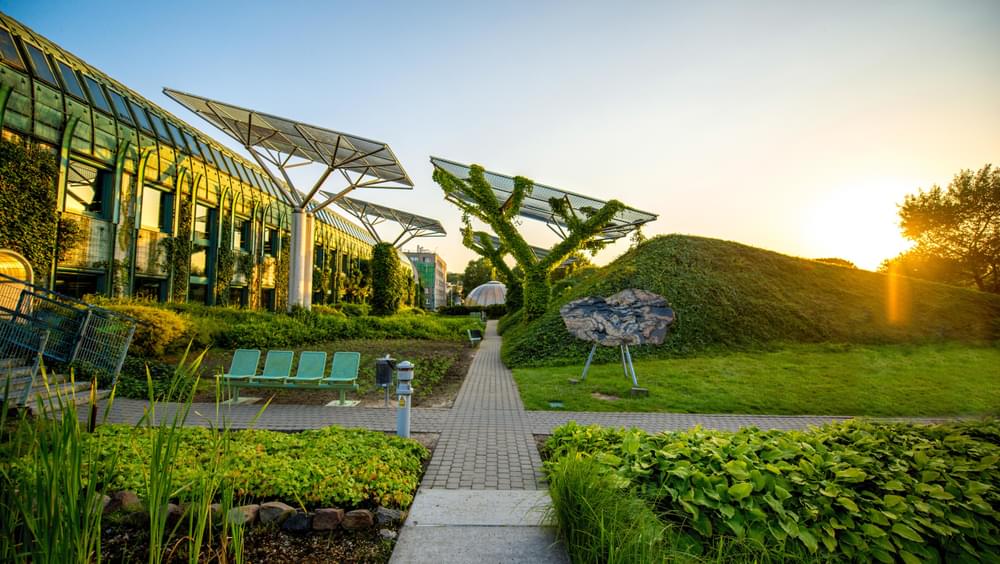There are a number of factors influencing how universities are being built. In the following article we focus on sustainability and explore what the sustainable campus of the future might look like.
Sustainability
Sustainability has become an embedded core value in the strategic planning of most UK universities. Minimising the environmental impact made on campuses through both policy and practice has become “the new normal”.
People & Planet University League table positions, EcoCampus ratings and Green Gown Awards are just a few of the accolades HE institutions boast about on their websites and in promotional campaigns. Green credentials have a strong appeal to prospective students and staff. Accordingly, institutions are scrambling to remodel existing or build new sustainable facilities in the knowledge that such credentials can be used as a selling point
Can campus expansion be sustainable?
To cope with rising student numbers, universities are currently carrying out their biggest enlargement programme since the 1960s . Flush with money from fees as well as access to cheap credit, money is being spent on award winning architecture and sustainable buildings that act as a differentiator to lure in fee-paying students and academics alike.
More buildings mean a greater carbon footprint (both during construction and in operation), and it has been said that the most sustainable building is the one that is never built. Even if these buildings are at the cutting edge of sustainable design, institutions are still increasing their carbon footprint. Having more bricks than necessary is expensive, regardless of how good those bricks are.
Nonetheless, when physical structures are deemed necessary, the sector aspires to develop sustainable and low-carbon emitting buildings. However, sustainability often comes at a cost as such buildings employ more premium construction techniques.
G&T has found that, on average, a sustainable building can carry a base build cost premium of up to 10% over and above a non-sustainable building.
As part of their sustainable campus plans, several universities in the UK have made the construction and refurbishment of buildings a primary area of focus. For example, the University of Plymouth’s plan requires that every new and refurbished building will achieve a BREEAM ‘Excellent’ rating, whilst the University of Nottingham have set a target that as a minimum all new capital projects should achieve a BREEAM ‘Excellent’ rating. Some of the University of Nottingham’s recent new builds include the following green features:
- Rainwater harvesting
- Living walls and green roofs
- Natural/recycled materials
- Passive design
- Biomass boilers
- Straw bale construction
Similarly, the University of Manchester’s Campus Masterplan seeks to reduce detrimental environmental impacts and maximise positive impacts. All new-build and refurbishment projects under the Masterplan will meet specific targets (eg carbon targets) to ensure environmental sustainability is considered from the outset, throughout the project and after completion. Such projects will be managed by a team of specialist environmental sustainability advisors (ESA’s) to manage sustainability on projects.
Many sustainable building plans, such as the University of Huddersfield’s for example, start from the premise of re-using or re-modelling existing buildings before demolition and replacement is considered. For refurbishments, many institutions use the SKA rating system - an environmental assessment method, benchmark and standard for non-domestic fit-outs. These sustainable ‘good practice’ measures cover energy and CO2 emissions, waste, water, materials, pollution, wellbeing and transport and are increasingly being used to demonstrate that sustainability considerations have been incorporated into every stage of a project.
The decarbonisation agenda is very close to the hearts of the sustainability-aware, younger generation. Universities are likely to feel a growing pressure from students pushing for campus-wide sustainability as opposed to just a few high-performing, sustainable trophy buildings. Could this pressure mean that UK university campuses will beat the Government’s target to reach new-zero carbon emissions by 2050? If so, is the construction industry ready to support them?





